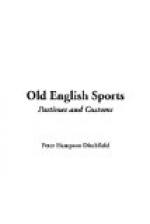There were also strolling companies of minstrels, jugglers, and jesters, who went about the country, and acted secular pieces composed of comic stories, jokes, and dialogues, interspersed with dancing and tumbling. The whole performance was very absurd and often indecent, and the clergy did their utmost to suppress these strolling companies.
The stage upon which the Mysteries were played was built on wheels, in order that it might be drawn to different parts of the town. Sometimes religious plays were acted in churches before the Reformation; but in Cornwall the people formed an earthen amphitheatre in some open field, and as the players did not learn their parts very well, a prompter used to follow them about with a book and tell them what to say. Coventry, York, Wakefield, Reading, Hull, and Leicester were famous for their plays, and in the churchwardens’ accounts we find many entries referring to the performances.
1469.—e.g. Item paid to Noah and
his wife ... ... xxi^d.
" " for a rope to hang the
ship in the church ... ii^d.
These performances would probably seem very foolish and childish to a modern audience, but they helped to enliven and diversify the lives of our more simple-minded forefathers.
The people, too, loved pageants which were performed on great occasions, during a Royal progress for instance, or to welcome the advent of some mighty personage. Great preparations were made for these exhibitions of rustic talent; long verses were committed to memory; rehearsals were endless, and the stories of Greek and Roman mythology were ransacked to provide scenes and subjects for the rural pageant. All this must have afforded immense amusement and interest to the country-folk in the neighbourhood of some lord’s castle, when the king or queen was expected to sojourn there. Shepherds and shepherdesses, gods and goddesses, clowns and mummers, all took part in the play, and it may interest my readers to give an account of one of these pageants, which was performed before Queen Elizabeth when she visited the ancient and historic castle of Sudeley.[16]




